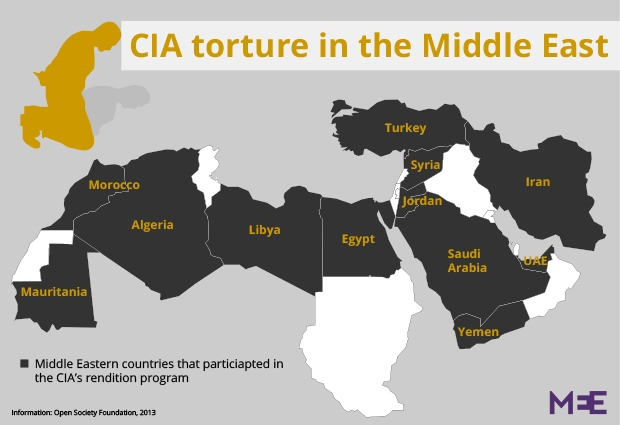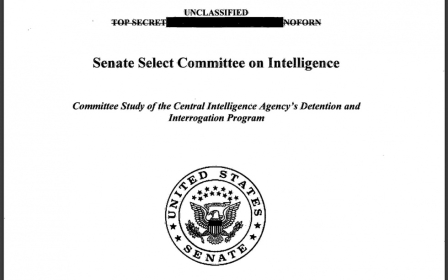How Arab states helped the CIA with its torture-linked rendition program

On Tuesday Mozzam Begg, a British Pakistani citizen and former Guantanamo bay detainee, was asked by a journalist from Sky News for his reaction to revelations about CIA torture documented in a new US Senate report.
“Do you feel any sense of vindication by what’s been revealed in this report?” asked the journalist.
“No,” said Begg, looking straight at the camera.“It’s something we’ve been talking about for the past thirteen years. When I was held [at Bagram detention center] guns were put to my head, I was kicked and punched on the floor, my clothes were sliced off with a knife by US soldiers… The US has admitted wrongdoing but what doesn’t happen is accountability,” said Begg.
Then he changed tack: “What about the outsourcing of torture? Syria, Egypt, Libya under Qaddafi, these are places where Britain and the United States of America were sending people to be tortured. It wasn’t just the CIA doing it by themselves, they couldn’t have done it by themselves, there had to be lots of accomplices.”
In addition to its own interrogation program, run out of “black sites” - secret detention centres outside the US - the Senate report has raised questions about the ways in which the CIA used a vast network of other countries – many in the Middle East – to help capture, detain, transport and torture detainees.
That network is shown in the CIA’s extraordinary rendition program – officially ended by president Obama in 2008 – under which the CIA could detain and interrogate foreign suspects without bringing them to the US or charging them with any crimes.
54 foreign governments supported the CIA’s program of extraordinary rendition, according to a 2013 report by the Open Society Foundation (OSF).
Of those 54, eleven were Middle Eastern states (Algeria, Egypt, Iran, Iraq, Jordan, Morocco, Saudi Arabia, Syria, Turkey, United Arab Emirates, and Yemen).
The degree to which those governments were involved in actual torturing of suspects varied, according to Sam Raphael, a lecturer in international relations at Kingston University. He is also co-founder of the Rendition project, which investigates US-led rendition and detention since 2001.
Some Arab states, such as Egypt, captured suspects on the CIA’s behalf and handed detainees over to the agency as well as permitting use of airports and airspace for flights associated with extraordinary rendition operations.
Others, like Jordan, which received several Pakistani citizens between 2001 and 2005, violently interrogated detainees on the CIA's behalf, said Raphael.
“This is what hasn’t been written into the Senate’s report: an account of how detainees were treated by foreign security forces… In many cases they were treated far more brutally than they were inside the CIA program,” said Raphael.
'Coffin-sized cells'
The most common destinations for rendered suspects, according to the OSF report, were Egypt, Morocco, and Jordan, all of which have been cited for human-rights violations by the State Department, and are known to torture suspects.
The Syrian government was also one of the "most common destinations for rendered suspects". In a prison known as "The Grave", due to its coffin-sized cells, some U.S.-provided detainees were subjected to "torture involving a chair frame used to stretch the spine (the 'German chair') and beatings."
Iran, typically considered an American foe, also participated in the CIA's programme by handing over 15 individuals to Kabul shortly after the US invasion of Afghanistan in 2001, in the full knowledge that they would fall under US control.
One reason Arab governments assisted the CIA in its interrogation program, analysts said, was to dent America's moral authority.
“Why would the Mubarak regime cooperate with the CIA? Principally because the United States would then be in no position to criticize them for their poor human rights record,” said Chris Doyle, director of the Council for Arab-British Understanding.
“It’s basically an insurance for them in terms of criticism from the US and a confirmation that they can conduct these brutal practises themselves,” he said.
The word ‘rendition’ appears 159 times in the declassified 525-page summary of the Senate report released on Tuesday.
One passage describes photographs of detainees in the process of being transported into U.S. military custody at Guantanamo Bay:
Detainees transported by the CIA by aircraft were typically hooded with their hands and feet shackled. The detainees wore large headsets to eliminate their ability to hear, and these headsets were typically affixed to a detainee's head with duct tape that ran the circumference of the detainee's head. CIA detainees were placed in diapers and not permitted to use the lavatory on the aircraft. Depending on the aircraft, detainees were either strapped into seats during the flights, or laid down and strapped to the floor of the plane horizontally like cargo.
Extraordinary rendition
One detainee whose story is frequently cited as an example of "extraordinary rendition" and who is not mentioned in the Senate report is Canadian engineer Maher Arar.
In 2009 Arar - who also has Syrian nationality - was on his way home to Canada from a family vacation in Tunisia when he was apprehended by authorities in New York. He was sent back to Syria where he endured months of brutal interrogation, including torture.
When Arar, who was later cleared by Canada of all links to terrorism, described his experience in an interview with the New Yorker he invoked an Arabic expression: the pain was so unbearable, he said, that “you forget the milk that you have been fed from the breast of your mother.”
In 2009 an executive order by President Obama’s administration established an interagency task force to review interrogation and transfer policies and issue recommendations on “the practices of transferring individuals to other nations.”
The interagency task force report continues to be withheld from the public.
“It appears that the U.S. intends to continue to rely on anti-torture diplomatic assurances from recipient countries," said Doyle, of the Council for Arab-British Understanding.
"But those methods were not effective safeguards against torture for Maher Arar who was tortured in Syria.”
Middle East Eye propose une couverture et une analyse indépendantes et incomparables du Moyen-Orient, de l’Afrique du Nord et d’autres régions du monde. Pour en savoir plus sur la reprise de ce contenu et les frais qui s’appliquent, veuillez remplir ce formulaire [en anglais]. Pour en savoir plus sur MEE, cliquez ici [en anglais].





